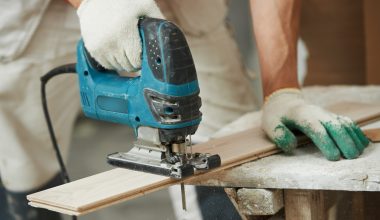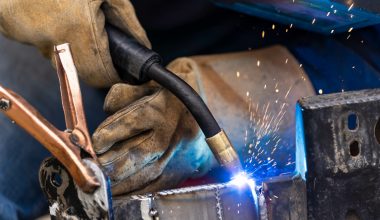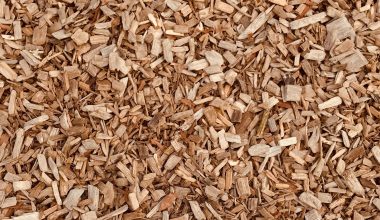Backpack Leaf Blowers: A Brief Introduction
If you’ve never tried using a backpack leaf blower, you’re in for a treat! Backpack leaf blowers might just be the most satisfying tool in the garage. As fall approaches and leaves begin to pile up on your once-pristine lawn, there is nothing quite like the feeling of blowing them to one side and into a neat pile. We highly recommend it!
Leaf blowers obviously come in all shapes and sizes. However, the backpack variety really does have some benefits over their handheld cousins. With the help of your favorite wheelbarrow, you will be cleaning up your yard in no time!
Why Choose A Backpack Leaf Blower?
There are a few significant advantages to backpack leaf blowers. Firstly, with the motor (or battery) strapped to your back, the weight of the machine is much better spread across your shoulders.
Secondly, as you navigate your yard to clear it, you don’t have to put the machine down. Things always end up in the way, and having two free hands is a big help.
Finally, because the weight is spread onto your back, these backpack leaf blowers are generally much more powerful than their hand-held relatives. In some cases, they deliver so much whoosh you could be forgiven for feeling like you’re wearing a jet pack!
In this deep-dive review, we’ve assembled our top picks for a variety of different use cases and buyers. We’ll also answer a lot of common questions buyers’ have about backpack leaf blowers in the final section.
What To Consider When Choosing Your Backpack Leaf Blower
CFM
CFM, or cubic feet per minute, is a measure of how much air the blower moves. Bigger motors will produce higher CFMs, which can be useful when you’re looking to cover large areas like lawns. If you use case is very heavy duty, you’ll want to combine a high CFM with a high MPH for maximum power. If you’re covering large areas without a heavy thing to blow, you could go for high CFM with lower MPH.
MPH
Miles per hour is the speed at which air comes out of the blower nozzle. You should be careful not to only measure a blower’s effectiveness on MPH because it’s not the whole story. In actual fact, you’re looking for a combination of MPH and CFM for maximum power.
Remember though, power comes with weight most of the time, so you should aim to pick a blower that meets your needs, not just the most powerful.
Weight
Since you’re wearing the machine on your back, weight is obviously a consideration. A lighter weight blower is undoubtedly better, but it often comes at the expense of power. You should aim to make a trade-off between the two. Indeed, if you are covering large areas of land there are lighter blowers that are designed for just that.
Fuel Capacity
For commercial and heavy users, good run time is important. Most commercial blowers will run for about an hour on a single tank, and it’s surprisingly similar across different machines in that category. Residential models with smaller tanks won’t last as long, but it’s not as important if you’re only doing light usage.
2-Cycle vs 4-Cycle
2-cycle motors will be your go-to for most professional applications because they are very powerful for their weight. That makes them very attractive for the commercial setting, but it does come at a price. They are generally louder and require a mix of fuel and oil to refuel them. This also adds some complexity for owners, as well as the additional mess and products to transport with your blower.
4-cycle motors are less powerful for their weight, as a general rule, but do come with their own advantages that make them attractive to the residential owner. These motors are generally a little quieter, and they just take regular gas as fuel. This makes them a little more straightforward to operate.
Ergonomics and Vibration
The leaf blower will be on your back, so making sure it’s comfortable will make a big difference in how enjoyable it is to use. All the blowers in this review are pretty comfortable, but the only way you can really be sure of how it’ll feel is to try and put one on. If that’s not an option, generally more commercial blowers will be more ergonomic.
Noise
If you’re using your blower in a residential setting, you should consider the noise of your blower because these are loud machines. The quietest backpack leaf blowers will be electric ones, followed by four-cycle machines and finally two-cycle machines.
If you’re a home user, you might want to look for the quietest machine possible. Aside from keeping your friendships with your neighbors, this could mean you can use your machine at more hours in the day, such as after you come home from work.
For commercial users, noise is not so much of a concern as landscaping companies are generally operating during normal work hours. There is also a general acceptance that the machines can be loud. That said, it’s worth ensuring that you have a good set of ear defenders. You can give yourself long-term hearing problems if you use loud machines for extended periods without adequate protection.
Cruise Control Setting
All the blowers in this review have the ability to hold a certain speed or throttle setting. This can be extremely useful when blowing for long periods of time. You should check any machines you are looking at have it, as it will help to prevent finger cramps from holding your hand down on the throttle.
Top 10 Backpack Leaf Blowers
Best Overall
1. Husqvarna 150BT
Specifications
Air Flow: 434 cfm
Air Speed: 251 mph
Dry Weight: 22 lbs
Motor Type: 2 cycle
Motor Size: 50cc
Fuel Capacity: 42 fl oz
Blowing Force: 20 N
Our Rating
Check Price
Our Take
The recipient of raving reviews, the 150 BT is Husqvarna’s mid-size blower, and still packs a big punch for a smaller and lighter unit than its bigger brother. For most residential and light commercial buyers, this will be a great choice, offering a good deal of power in a small, light and reliable package.
With a 20N blowing force coming from the 2.15hp motor, this model weighs in at a comparatively light 22lbs, making it comfortable to wear for long sessions in the yard. It’s worth mentioning that this blower uses a 2-cycle X-Torq motor, which may not be everyone’s choice because of the need to pre-mix the fuel. That said, it’s a small sacrifice to pay to get huge power in a lightweight package – something that isn’t achievable with a 4-cycle or electric motor.
Best of all, it’s hugely competitive from a price perspective, making it very attainable for most homeowners. In addition, with Husqvarna’s wealth of experience as an industry leader in garden equipment, you can feel confident that you’re buying a quality and long lasting machine.
Best Value
2. Troy-Bilt TB2BP
Specifications
Air Flow: 445 cfm
Air Speed: 145 mph
Dry Weight: 17.8 lbs
Motor Type: 2 cycle
Motor Size: 27cc
Fuel Capacity: 20 fl oz
Our Rating
Check Price
Our Take
Another solid candidate for the value category, the Troy-Bilt TB2BP is a smaller 27cc 2-cycle blower at a very attractive price. For residential owners who don’t expect to put their tools through as much work as a commercial owner, this might just be a winning choice.
Producing decent volumes of air at lower speeds (445 CFM and 145 MPH), this blower puts out adequate numbers for most small yards with moderate leaf fall. That smaller motor also keeps it light – and at 17.8lbs, it’s among the lightest in this review.
This blower also has a number of innovations aimed at making life a bit easier for the residential owner. It is compatible with Troy-Bilt’s Jump Start technology, which although sold separately will eliminate the need to pull start. A Coolflex backpack design reduces fatigue and keeps the operator cool, making it a comfortable product to use. A Long Flex Tube allows you to maneuver around with ease.
Equipped with a smaller 20 fl. oz. tank, this blower won’t be the best choice for very large areas or particularly long sessions. All in all we would say this is a great residential selection, with decent capacity and various convenience enhancing features. Offered at a great price, it’ll be a great fit for most homeowners, despite only being 2-cycle and with a smaller engine.
Best Commercial
3. Husqvarna 580BTS
Specifications
Air Flow: 908 cfm
Air Speed: 206.2 mph
Dry Weight: 25 lbs
Motor Type: 2 cycle
Motor Size: 75cc
Fuel Capacity: 87 fl oz
Blowing Force: 40 N
Our Rating
Check Price
Our Take
The Husqvarna 580 BTS is a powerhouse of a machine and had quite rightly earned a loyal following in the commercial market. It’s Husqvarna’s most powerful offering and delivers a whopping 206 mph airspeed at 908 cfm (cubic feet per minute). Not only is that one of the highest airspeeds in this review, but with a very high cfm, it equates to a lot of pushing power – 40N of blowing force to be exact.
Digging into the finer features, all that power comes at the expense of some weight, and at 26lbs this is one of the heavier blowers. That makes it very well suited to commercial or heavy stress environments, but potentially not the best blower for the typical back yard homeowner.
Equipped with an impressively large tank, this blower has a huge 87.9 fl. Oz tank which will give it a huge run time for long blowing sessions. At 440 g/kWh fuel consumption, that equates to about a 1 hour reported run time, which is standard for commercial blowers.
In summary, if you’re looking for a heavyweight commercial blower, this is an excellent choice. Huge pushing power combined with a large fuel tank and a well-respected brand make this a great selection for heavy-duty applications.
4. Husqvarna 350BT
Specifications
Air Flow: 494 cfm
Air Speed: 180 mph
Dry Weight: 22 lbs
Motor Type: 2 cycle
Motor Size: 50cc
Fuel Capacity: 42 fl oz
Blowing Force: 21 N
Our Rating
Check Price
Our Take
Aimed at large landowners, or applications where bigger areas need to be cleared, the 350BT sits between the 580 and the 150 models from Husqvarna. This is a lightweight package, weighing in at just over 21lbs, and designed to be worn for long periods.
From a technical perspective, it features a high CFM but a relatively low air speed, making it ideal for moving sparsely distributed leaves across a large area like a field or large lawn. If you suffer from very heavy leaf fall, you might look to the 580 models greater pushing power, as this model generates a more middle of the road 21N of pushing force.
Like all the Husqvarna models, this blower is equipped with their Air Purge system. This innovation makes the blower easier to start by clearing air out of the carburetor and making the pull start process less strenuous.
In summary, this blower will be a great choice for you if you’re expecting longer blowing sessions across large areas of less densely packed leaves. Coming in about average from a price perspective, it’s a great blower for the money and will serve you well if you needs are suited to it.
5. Echo PB-580T
Specifications
Air Flow: 517 cfm
Air Speed: 216 mph
Dry Weight: 22.7 lbs
Motor Type: 2 cycle
Motor Size: 58cc
Fuel Capacity: 62 fl oz
Blowing Force: 22 N
Our Rating
Check Price
Our Take
With over 40 years of experience in power machinery, it’s no surprise that Echo’s PB-580T enjoys a strong following. As a mid-sized blower, the PB-580T features a 58cc two-cycle motor, coming in at 22lbs.
From a stats perspective, this is another blower well suited to large areas of land, with a relatively modest max MPH, mid-range 22N blowing force, and a large CFM. Equipped with a big 62 fl. Oz. tank, this blower will give you a very good run time for clearing large areas of low-density leaves.
It has been reported that this blower can be slightly susceptible to producing vibrations, but at a very competitive price point it’ll remain appealing to owners that like to buy American. There’s no doubting that many commercial landscapers have a great loyalty to the brand – with Echo’s string trimmers being amongst the most popular out there. This leaf blower is certainly no different – and for the right type of buyer, it’ll be a great choice.
6. Mellcom Cordless Leaf Blower Backpack
Specifications
Air Flow: 750 cfm
Motor Type: 4 cycle
Motor Size: 76cc
Engine Size: 2 L
Our Rating
Check Price
Our Take
Mellcom’s Cordless Leaf Blower is quite a different blower from many in this list for a number of reasons. Firstly, it makes use of a 4-cycle motor, which some buyers will find hugely attractive, and second, it’s very adjustable to fit all types of people, and can be easily switched on and off with only one hand. The switch handle is also fully adjustable to control the air volume.
This is an extremely powerful blower, which might not be for everyone. Equipped with a high performance 76cc motor, it does a lot on the pushing power front. Dishing out 750 CFM this blower is great for larger spaces where you need a lot of power.
The Mellcom leaf blower includes some great features. First off, you won’t have to make your messy oil and fuel mix with this blower, as it’s a conventional 4-cycle engine taking pure gasoline. Some buyers will find that appealing, having grown frustrated with carrying around mixing containers and other paraphernalia.
All things considered, this is a high performer which comes at a very decent price point. For residential users, the added ease of use of electric starting and a 4-cycle motor could make this machine very attractive. Although, it’s quite powerful, so it may be more appealing if you’ve got a big area to use it on.
7. Poulan Pro PR48BT
Specifications
Air Flow: 475 cfm
Air Speed: 200 mph
Motor Type: 2 cycle
Motor Size: 48cc
Our Rating
Check Price
Our Take
The PR48BT from Poulan Pro sits squarely in the medium-sized blower category. Equipped with a 48cc 2-cycle motor, this blower is the cheapest on the test and certainly won’t break the bank.
That said, it doesn’t quite develop the power of some of the more premium offerings, and there have been concerns about reliability shared online. Pushing out 475 CFM at 200 MPH, this blower will take care of most residential and light commercial applications. At 22lbs it isn’t especially heavy or lightweight, so sits firmly in the middle of the bunch from that perspective.
For homeowners working to a tighter budget, who don’t have the toughest of requirements, this blower could be a good option. That said, it’s worth taking the time to think about your leaf blowing requirements, because if you need to take on a bit more than you initially expected you could benefit from investing in one of the other blowers.
8. Makita EB5300TH
Specifications
Air Flow: 516 cfm
Air Speed: 184 mph
Dry Weight: 19.7 lbs
Motor Type: 4 cycle
Motor Size: 52.5cc
Fuel Capacity: 60.9 fl oz
Our Rating
Check Price
Our Take
Commercial users looking for a blower to cover large areas will be hugely excited about the Makita EB5300TH. Another 4-cycle blower, this model is packed with features designed to make long blowing sessions significantly easier.
Looking at the numbers, this is a lightweight blower, weighing in at 19lbs, but it still manages to move a lot of air with its 52cc motor. Propelling 516 CFM at slightly lower speeds of 184 mph, this blower is well suited to covering large areas of land. Additionally, it features a large 60 oz fuel tank, so you can expect to get a great run time of well over an hour per tank.
Owing to the 4-cycle motor, this blower is also one of the quieter gas blowers in the test, and you can expect more of a thumping sound rather than the traditional squeal of a 2-cycle.
Not necessarily the top performer in any particular category, this product is still a very good blower and will be very attractive to commercial owners in particular due to the lightweight and quieter 4-cycle motor.
9. Thanos No-Pull Backpack Leaf Blower
Specifications
Air Flow: 850 cfm
Air Speed: 230 mph
Motor Type: 2 cycle
Motor Size: 63 cc
Fuel Capacity: 1.7 L
Our Rating
Check Price
Our Take
The Thanos No-Pull Backpack Leaf Blower is a high-performance blower at a low price.
With a whopping 63cc motor, this is one powerful blower and is capable of blowing some serious leaf volumes. From a numbers perspective, its doing 850 CFM at 230 MPH, producing a blowing force to reckon with.
All that equates to an excellent blower for commercial users – but what about the weight? Coming in at 21.6lbs, the weight is impressive on this blower, making it a solid choice for extended use. The 1.7 L fuel capacity is not the largest in this review, but it is still large and has a good blowing time.
This model is designed with an s-shaped impeller to make cleaning more efficient and to provide you with better blowing power. Low-emission technology makes this unit durable and reliable. For commercial settings, this, the Mellcom, and the Husqvarna’s will both be great choices. If you’re looking for a high powered blower for heavy residential use, then this would be a great choice for you as well.
10. RYOBI RY40440
Specifications
Air Flow: 625 cfm
Air Speed: 145 mph
Dry Weight: 21.2 lbs
Motor Type: Electric
Blowing Force: 20 N
Our Rating
Check Price
Our Take
As they have in so many other categories, Ryobi continue to push expectations for electric yard machinery. The RY40440 is their only backpack electric offering, but looking down the specifications it will catch your eye right away.
Pushing out 625 CFM at 145 MPH, the basic numbers are certainly not bad for this blower, and the significant reduction in noise is certainly nothing to sneer at. In fact, it’s almost half as noisy as most gas versions, so for some buyers that will be a serious check in the pros column.
That said, the 5AH battery will only produce 30 minutes of blowing time, which is quite a lot less than many of the gas powered rivals. However, you can actually attach a second battery to this machine, using the two active battery ports to give you additional run time. What’s more, batteries are interchangeable for many of their tools, so in a residential setting the short battery life may not actually pose a big problem.
Like many of Ryobi’s other tools, the RY40440 is well designed for the residential market, and should pack enough of a punch in all but the heaviest of use cases. With the option to swap out or add second batteries, the big reduction in noise and the increased cleanliness of an electric blower makes it a very strong candidate. We wouldn’t hesitate to recommend it to you if you fall into this category – most residential owners will find it an excellent buy.
Buyer’s Guide Questions
MPH Or CFM – Which Is Important?
You’ll often see both these numbers quoted above, and also extensively on spec sheets. We’re here to help you break it down and understand what all the numbers mean for your blower.
What Is MPH?
MPH stands for miles per hour and is the speed at which air exits the nozzle of the blower. This can be a factor in the power of the blower, but it’s not the whole story. If you imagine a very small pipe with air being pumped through it, you could achieve a very high MPH, but it would be a very focused beam of air. That’s where CFM comes in.
What Is CFM?
CFM stands for cubic feet per minute and is a measure of the quantity of air moved by the blower. A very powerful blower will have a very high CFM and a high MPH. Imagine a heavy freight train moving at high speed – not something you want to get in the way of!
The nuance comes with balancing the two, however. Let’s say you have a large area to cover (like a big lawn), with relatively light leaf fall. In that instance, we recommend a blower with a relatively higher CFM but only a medium speed. This is because it’ll have a nice wide band of air, with enough power to move small leaves.
In heavy-duty applications, you’ll need both the CFM and MPH to generate blowing force. This will help move heavy objects or large piles of leaves. Obviously, that power comes with additional weight and cost attached. You’ll need to make a judgment for yourself about exactly what type of usage characteristics you require.
How Do You Start A Leaf Blower?
Leaf blowers, much like chainsaws, can be a little tricky to start. Once you get the hang of it though, you’ll find it relatively straightforward. We’ll only discuss starting the gas blower here since the electric models are pretty straightforward on and off switch.
Pre-Start Routine
Begin by checking that the power switch is in the on position. Often it won’t be after the previous user shuts the machine down. Have a quick look and make sure you have adequate fuel.
Next, you’ll want to engage the choke by putting it to the start setting. Move the throttle to a mid-setting. Now you’re ready to start, so find yourself a steady big of level ground (muddy ground won’t work), and make sure the air ducts on the back of the blower are clear.
Starting Your Leaf Blower
When you’re ready to start, stand the blower upright, with your foot against the base. Next, use one hand to hold the backpack steady, and the older to grip the starting cord. Pull the cord gently until it engages, and then pull it hard. Do this repeatedly until the mower fires.
If it’s not firing after 5-10 pulls, and if it’s getting stiffer to pull, you may have flooded the machine. When that happens, you’ll need to leave the machine for 10 minutes before you try again.
If it has fired and the engine is now running, flick the choke back to the off position, and now leave the blower for a minute or two for the engine to warm up before you start to use it.
What Is The Best Value Gas Leaf Blower?
It’s a complex question really and depends on what you’re going to use your blower for. We’ll describe some of the main use cases, and which blowers we think are the right choice.
Best Commercial Leaf Blower
For commercial applications, the best blower for the money might not necessarily be the cheapest one. If you buy a cheap one that isn’t up to the job, you’ll end up wasting more money on parts and/or an actual replacement.
We would suggest you look at the Husqvarna 580BT, the Makita EB5300TH, or the Thanos or Mellcom models. These are all hugely powerful and hugely reliable blowers that are very popular with the commercial community.
For more of our commercial level reviews check out our guide to the best commercial pressure washers.
Best Residential Leaf Blower
For a heavy residential user, who perhaps has a larger yard area and a heavy leaf fall, there are a number of good options. Here again, you’ll be looking for something that can do the job, is reliable, and is easy to use. Our top recommendation would be the Husqvarna 150BT, which comes with many of the features of the commercial blowers in a smaller and lighter package.
For a light residential user who is working to a budget, the Troy-Bilt TB2BP is probably your best choice. These are good light residential blowers and work well for light seasonal use. Their price point reflects this – but it’s worth noting they aren’t a whole lot cheaper than the Husqvarna 150 BT. Given that fact, we’d probably opt for the Husqvarna.
How Do You Use A Leaf Blower?
Although a relatively simple tool, backpack lead blowers can actually cause nasty injuries if you don’t observe some obvious precautions. Most importantly, it’s critical to make sure your machine is well maintained, and regularly serviced by a certified garden machinery business. Some people also like to use their riding lawn mower prior to leaf blowing to aid in the cleanup.
Fuel Or Electric
Before you get started with blowing leaves, your first job is to fuel up your blower. For backpack leave blowers, the fuel tank is found on the backpack portion of the device. Now, machines fall into three categories, electric, 2-cycle, and 4-cycle.
Electric ones are obviously not worth discussing because you just charge them, but for 2 cycle motors, you’ll be fueling them up with a mixture of two-cycle oil and water. A typical ratio for this is 50 parts fuel (regular unleaded gas) to 1 part 2 cycle oil. You’ll want to double-check your machine for any specific requirements since these ratios do vary slightly from motor to motor. For a 4-cycle motor, you can fill it up with regular unleaded gas.
Before You Start
Before you start the blower, you will want to ensure you’re appropriately dressed. First off, eye protection is a must for leaf blowers, as stones and debris can easily rebound into your eyes and cause long-term injury. Next up, you should make sure you’re wearing pants and a long-sleeved shirt. Overalls work great, and a bandana over your mouth or a mask will also help with the dust.
Next up, make sure you’ve got adequate ear protection. Backpack leaf blowers are actually very noisy as machines go, and because they are strapped to your back, the noise is very close to your ears. You’ll want to get the best ear protection you can lay your hands on.
One final point before you get started – be courteous with the time of day you’re running your blower. Unless you have an electric machine, you could end up making your neighbors very unhappy if you’re running it late at night or early in the morning!
Best Practices
Once you’ve started the machine, you’ll be making a sweeping movement with the blower to push leaves like you would with a broom. Aim to work in sectors, and push the leaves into piles for collection and disposal. Be especially careful when working your way around shrubs or other plants, and you can easily damage the leaves. Sometimes a smaller lawnmower is more effective at going around the edges of your garden.
If you have a powerful blower be careful working around parked cars, buildings or people, and always make sure you’re blowing away from them. Did you know one study found that rotting leaves contribute to greenhouse gases?
How Much Is A Leaf Blower?
Prices vary greatly depending on what type of blower you’re considering, whether it’s a commercial or residential machine. For commercial machines, you should be looking to pay $350-$500 for a good machine. This will be a great investment if you’re a heavy user, and we would strongly discourage you from trying to play it cheap – it’ll only come back to bite you in the end.
For a residential blower, you’re looking at closer somewhere between $200-$350 for a residential backpack leaf blower.
What is the Top commercial leaf blower?
For commercial usage, there are a huge number of great options out there. We would suggest you consider your use cases in more detail before you make a decision. Broadly, we fit commercial blowers into two groups.
Lightweight blowers with low speed and high CFM are great for covering large areas.
Heavy-duty blowers for moving large quantities of leaves and materials.
For the first use case, we recommend the Husqvarna 380BT or the Makita EB5300TH. If you’re looking for a hard-wearing and heavy-hitting blower, we suggest the Husqvarna 580BT or the Mellcom or Thanos models















